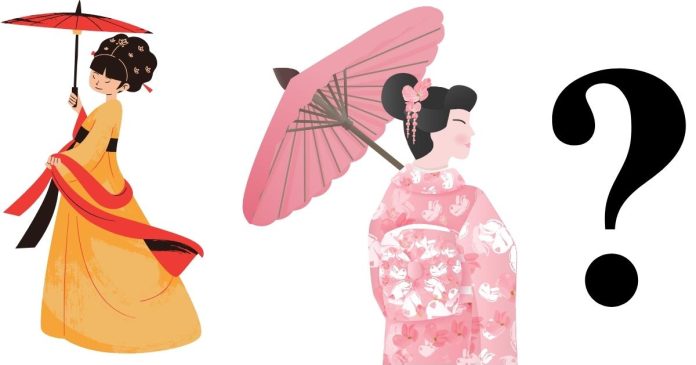China and Japan are two of the most influential nations in East Asia, each with a rich history and vibrant culture. Despite geographical proximity and historical interactions, their cultural landscapes are distinct, shaped by unique traditions, philosophies, and societal values. This article looks at the key differences between Chinese and Japanese cultures, touching on areas like language, religion, social norms, cuisine, and aesthetics.
1. Language
The languages of China and Japan are fundamentally different in structure and origin.
- Chinese: The Chinese language, primarily Mandarin, is a tonal language where the meaning of a word can change based on its tone. Chinese characters, known as hanzi, are logographic, meaning each character represents a word or concept.
- Japanese: The Japanese language incorporates three writing systems: kanji (borrowed Chinese characters), hiragana, and katakana. While kanji is derived from Chinese hanzi, the Japanese language itself is not tonal and has a different grammatical structure, including subject-object-verb word order.
2. Religion and Philosophy
Both cultures have been influenced by similar philosophies and religions, but their practices and emphasis differ.
- China: Chinese culture is deeply rooted in Confucianism, Taoism, and Buddhism. Confucian principles emphasize hierarchy, respect for elders, and familial piety. Taoism focuses on harmony with nature and the pursuit of balance.
- Japan: Shinto, Japan’s indigenous religion, emphasizes a connection with nature and the worship of kami (spirits). Buddhism, imported from China, is also prominent but has evolved uniquely in Japan. Japanese culture integrates these beliefs into rituals and festivals that are distinct from Chinese traditions.
3. Social Norms and Values
The societal behaviors in China and Japan reflect their cultural values.
- China: Chinese culture places a strong emphasis on collectivism, where family and community are central. Interactions are often more direct, and expressing one’s opinions is generally acceptable. Relationships in business and personal life are built on trust and long-term connections, known as guanxi.
- Japan: Japanese society is also collectivist but highly emphasizes harmony (wa), politeness, and avoiding conflict. Communication tends to be indirect, with people often implying rather than stating things explicitly. Punctuality, attention to detail, and respect for hierarchy are critical aspects of Japanese etiquette.
4. Cuisine
The culinary traditions of China and Japan are iconic but differ significantly in flavors, ingredients, and presentation.
- Chinese Cuisine: Chinese food is diverse, with regional cuisines like Sichuan, Cantonese, and Hunan offering bold flavors. Dishes often feature ingredients like rice, noodles, soy sauce, and a variety of meats, along with cooking techniques like stir-frying and steaming.
- Japanese Cuisine: Japanese food emphasizes simplicity, fresh ingredients, and aesthetic presentation. Staples include sushi, sashimi, miso soup, and rice. Japanese cuisine often focuses on seasonal ingredients and meticulous preparation methods.
5. Aesthetic and Artistic Traditions
Artistic expressions in China and Japan highlight their distinct cultural values.
- China: Chinese art reflects themes of nature, spirituality, and philosophy, often seen in calligraphy, landscape painting, and ceramics. Chinese architecture is grand and ornate, characterized by curved roofs and intricate carvings.
- Japan: Japanese aesthetics value simplicity and impermanence, concepts rooted in wabi-sabi. Traditional arts like ikebana (flower arranging), tea ceremonies, and Zen gardens emphasize minimalism. Japanese architecture is often understated, focusing on natural materials and harmony with the environment.
6. Festivals and Celebrations
Festivals in both cultures are vibrant and deeply rooted in tradition but differ in purpose and rituals.
- China: Major Chinese festivals include the Lunar New Year, Mid-Autumn Festival, and Dragon Boat Festival. These celebrations often involve family reunions, elaborate feasts, and traditional performances.
- Japan: Japanese festivals, or matsuri, are linked to Shinto beliefs or seasonal changes. Events like the cherry blossom festivals (hanami), Obon (honoring ancestors), and Gion Matsuri (a famous Kyoto festival) are integral to Japanese cultural life.
7. Historical Influence and Modernization
- China: As one of the world’s oldest civilizations, China has a long history of imperial rule and innovations like paper, printing, and gunpowder. In modern times, China has rapidly industrialized while retaining traditional elements in rural areas.
- Japan: Japan’s history includes periods of isolation and modernization, particularly during the Meiji Restoration. The country has preserved its traditions while becoming a global leader in technology and innovation.
While China and Japan share historical ties and some cultural similarities, their differences reflect the unique evolution of each society. Chinese culture is characterized by its deep philosophical roots, diverse cuisines, and bold artistic traditions, whereas Japanese culture emphasizes harmony, simplicity, and meticulous attention to detail. Understanding these distinctions not only enriches our appreciation of these cultures but also fosters greater respect for their individuality.
Related posts:
- What does ringing in the ears mean spiritually?
- What Colors Do Blue and Green Make?
- How Long Does Raw Chicken Really Last in the Fridge?
- What are some amazing and memorable Valentine’s Day ideas that will leave a lasting impression?
- What is the definition of ‘friends with benefits?
- What is the difference between a bachelor’s and a degree?



